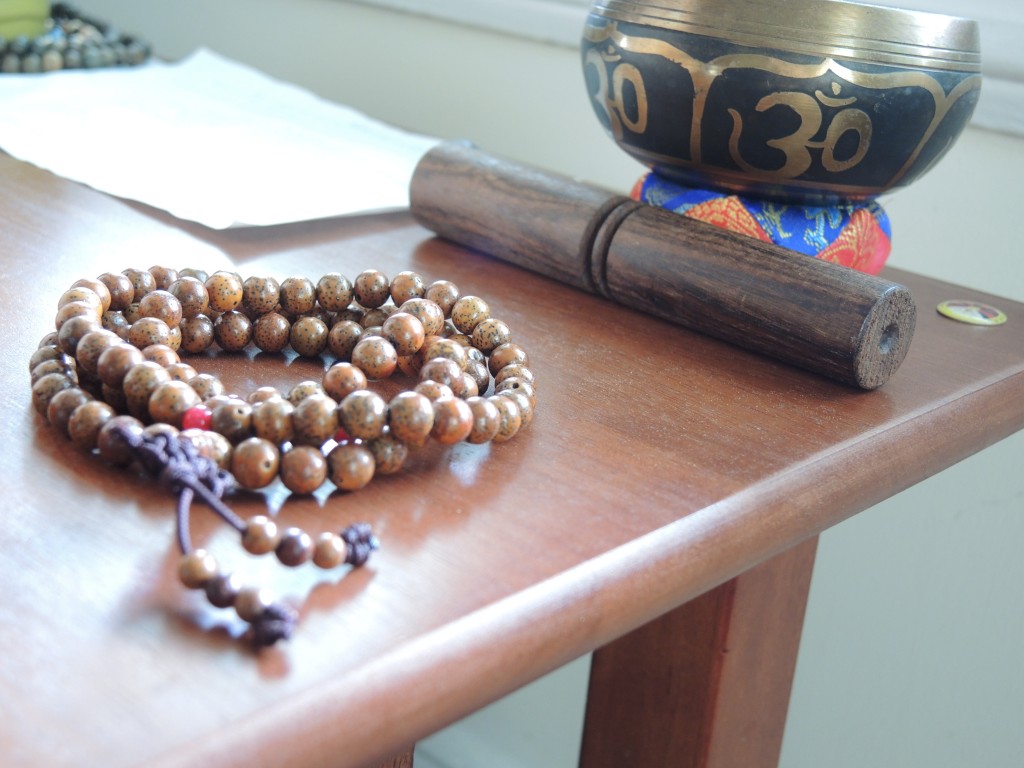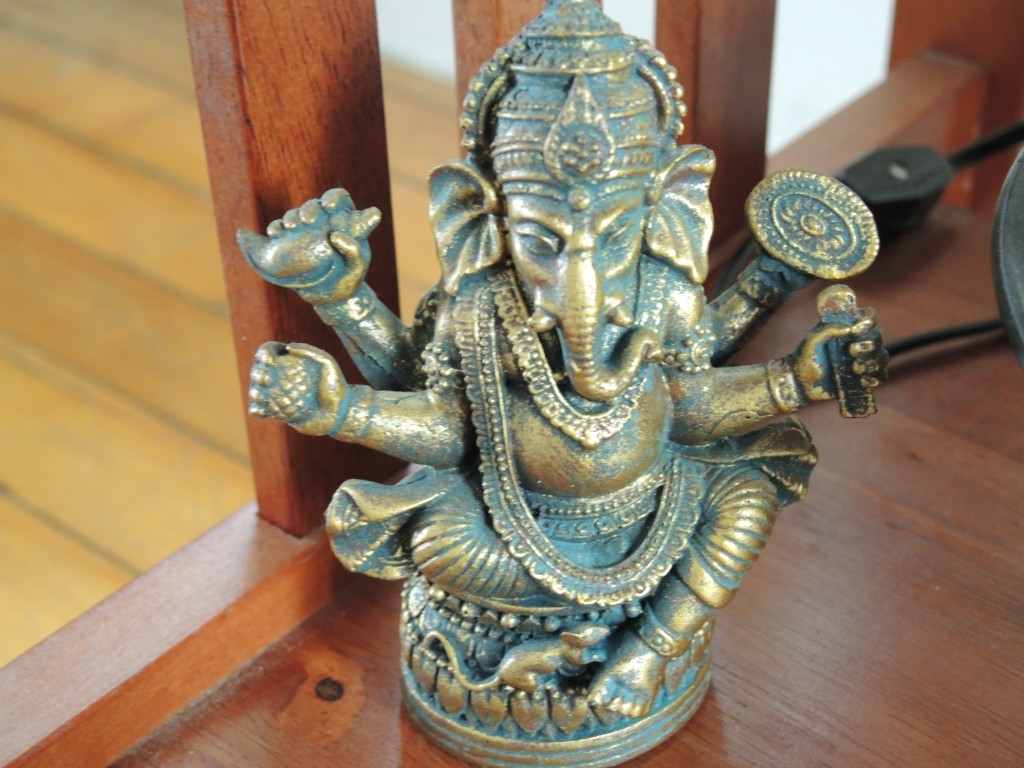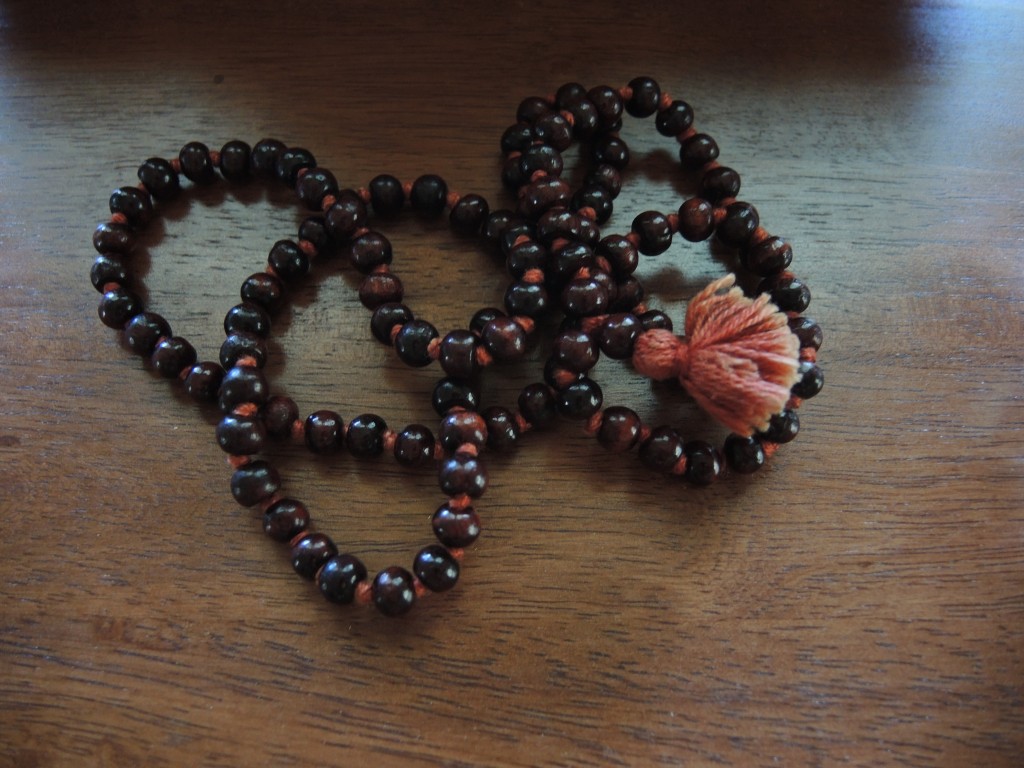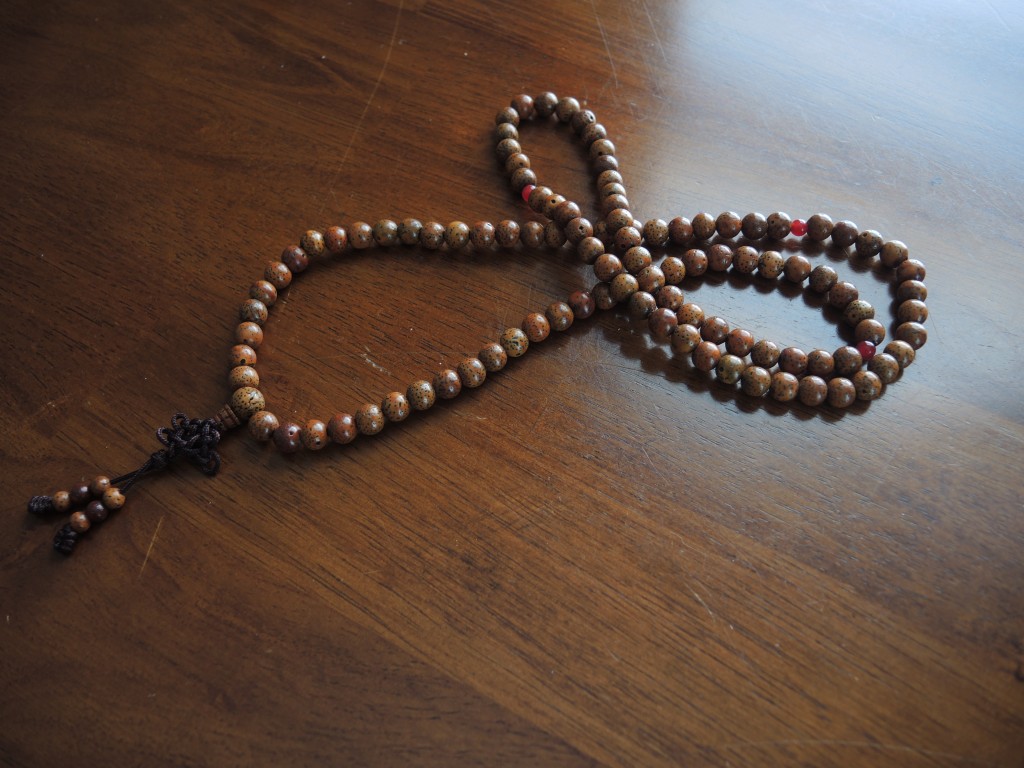Believe it or not, the mala beads that grace yogis’ wrists and necks on magazine covers and on fashionable practitioners are more than just decoration, well, at least they are for some. Though they’ve started to lose their trendiness, mala beads can still be found in abundance. Although I own six sets, three of which I made by hand reciting a seed sound with each knot between the round beads, you won’t see me flaunting them around my wrists as jewelry. When I do wear a set I slide them around my neck and let them fall under my shirt. I have come to honor and believe in the ancient practice of mantra recitation and wouldn’t want my displaying a mala to be mistaken for fashion.
Mantras, or the repetition of sounds, words, or phrases as prayer or a means of meditating or refocusing in our busy lives, have been used for centuries as a powerful healing, balancing, and purifying force. With the explosion of yoga into popular culture, Sanskrit mantras are now the popular background music in many studios and gyms. Artists like Krishna Das, MC Yogi, and Deva Premal have become standard names in modern chanting. You don’t, however, have to become an expert in an ancient language to use and appreciate mantra. Using words or phrases that are personally meaningful to you in your native language can be just as effective.
The well known rosary beads of the Catholic faith were modeled after ancient malas. A traditional mala contains 108 beads, an auspicious number in Buddhism and Hinduism, that are used as place markers as you silently or verbally recite a mantra. Reciting a round of 108 mantras for 40 days is thought to be the ideal length for working with a certain sound and evoking change in your life. The act itself of sitting silently and repeating a mantra is a way to calm the thoughts and to drop into meditation. If you are new to meditation and looking for a way to focus, repeating a mantra can be the perfect way to bring yourself back as your mind begins to wander.
You don’t need to own a fancy set of beads, sit for hours in meditation, or contort yourself into painful yoga postures to benefit from mantra recitation. You can begin to use mantra in your day-to-day life by thinking of an intention– something you are working toward– and assigning a word or phrase that will allow you to return to that intention when you feel yourself losing focus. Your word could be the name of a place that brings you peace, a feeling, or a desired mental state.
If you are interested in Sanskrit mantra, I’d highly recommend the book Healing Mantras: Using Sound Affirmations for Personal Power, Creativity, and Healing by Thomas Ashley-Farrand. Complete with personal stories of the author’s healing as well as the effects of mantra on others, clear pronunciation guides, and explanations for each seed sound of the traditional mantras, you are sure to find one that strikes a chord with you, wherever you find yourself presently in life. The book is organized into chapters for various modern day “needs” such as attracting love, promoting health, mastering fear, and evoking self-empowerment, abundance, and prosperity.
On my birthday in May I attended a Tibetan arts, music, and culture festival and purchased a new set of malas as a gift to myself. Weeks later, before embarking on my road trip, I went through Healing Mantras in search of a new mantra that resonated with me. I chose the mantra associated with Ganesha, the Hindu god thought to remove obstacles and represented as an elephant. Years ago I bought a small Ganesha statue to place on my home altar. A week after I brought him into my home my husband declared he was leaving. When he first made the decision to move out I was devastated, but with time I’ve come to realize that we had both been obstacles to each other and that his leaving helped to open up new pathways I would not have experienced otherwise.
A good friend of mine bought me a small Ganesha figure that I carried with me, along with my mala, in my purse across the United States. The mantra, Om Gum Ganapatayei Namaha, was the first one I recited without fail, without missing a day and having to begin again for forty straight days. Despite being on the road, I remained faithful to my nightly meditation ritual. Along the way I also worked with Om Dum Durgayei Namaha, a mantra for protection that I’ve used to charge a rosewood set of malas that I carry with me and wear tucked under my shirt each time I travel. It might sound silly or superstitious to place so much power in the mantra or carrying a small statue, but so often in my month long trip I felt that things were working out exactly as they were meant to, that I was being watched over and protected along the way. Obstacles, both mental and physical, began dropping away allowing me to have the trip of a lifetime and return home safe and without harm.
When I returned home I fell into a rut brought on by indecision. On the trip I knew with certainty that I had to make a major life change, a decision that was equally terrifying and liberating, one that I knew would not gain me the support of others. At home, faced with the reality of the situation, the reality that I would soon have to make a decision one way or another, I found myself lying awake at night worrying, alternating between moments of clarity and peace and feelings of fear and anxiety. I had stopped using mantras, stopped meditating, stopped doing yoga, in essence I eliminated all of the things that have helped me through difficult times.
After a week of this flip-flopping between knowing and not knowing, still unable to commit to one choice or another, I woke up one Saturday morning with a name in my head– Thomas Ashley-Farrand. I thought of his name as I brewed my morning coffee, ate my breakfast, showered, and began my day. I couldn’t remember who he was and had no idea why his name had found its way into my sub-conscious. Then it came to me– the mantra book.
I pulled the book off my shelf and intended to look through it, but allowed my normal Saturday routine of food shopping, cleaning, and laundry to distract me. As I tidied up my house I placed the book back on the shelf without a second thought. I spent the evening having coffee with a friend, then went to a free Shakespeare play on the Boston Common. As I got off the train and headed toward the park from Downtown Crossing I was overwhelmed with this feeling that something terrible was going to happen. I fought back the panic attack, darted my eyes into every dark corner and alley, and prepared myself for attack. None came, but the feeling of dread did not subside. I sat through most of the play, but went home early unable to shake the feeling that had come on so suddenly and refused to dissipate.
After another sleepless night, I got up the next morning and noticed the sunlight slanting in through my front room windows and falling perfectly onto my meditation cushion and altar. I pulled Healing Mantras off my shelf again and glanced through it over my breakfast. I expected to find a new mantra, one perhaps for making decisions, but again felt drawn toward the one I had been working with– Om Gum Ganapatayei Namaha— and had abandoned upon returning home from my trip. Reciting it felt right, necessary even.
I sat in meditation, recited 108 rounds of Ganesha’s mantra, then flipped my mala and recited it 108 more times. When I was finished I sat in silent meditation, recited a metta practice given to me by a dear friend and spiritual teacher, and finished with a prayer. I asked for divine guidance, a sign of sorts, for help in making up my mind and having the strength to go with whatever decision I made.
I stood up from my meditation cushion and walked into my living room where I picked up my phone, sensing that I was going to receive an important message. The instant I cradled the phone in the palm of my hand I received a text message from my mother asking me to call her. She would tell me something that changed everything, explained my panic attack from the night before, and allowed me to make a decision that I knew was necessary. A life change that I knew with certainty in my heart was the right one for me and for my family.
Now, at a time when I have no idea where I will be or what I will be doing in the coming weeks and months, I know one thing for sure, I will continue to use mantra to guide me, calm me, and lead me through the uncertainty of the future.






